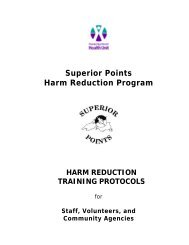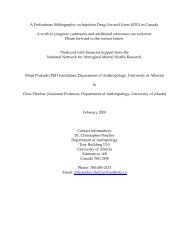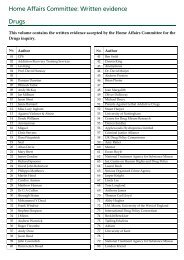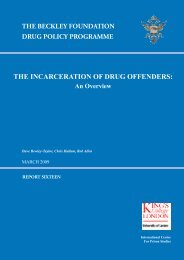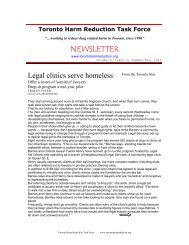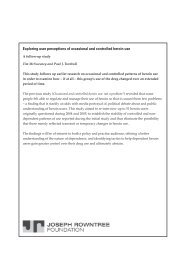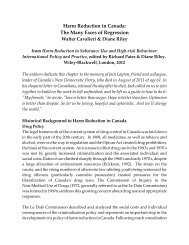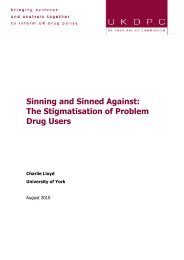and the building of the harm reduction-abstinence ... - ResearchGate
and the building of the harm reduction-abstinence ... - ResearchGate
and the building of the harm reduction-abstinence ... - ResearchGate
Create successful ePaper yourself
Turn your PDF publications into a flip-book with our unique Google optimized e-Paper software.
Journal <strong>of</strong> Substance Abuse Treatment 25 (2003) 241–247<br />
Discussion<br />
On ‘‘Gradualism’’ <strong>and</strong> <strong>the</strong> <strong>building</strong> <strong>of</strong> <strong>the</strong><br />
<strong>harm</strong> <strong>reduction</strong>-<strong>abstinence</strong> continuum<br />
Scott H. Kellogg*<br />
Laboratory <strong>of</strong> <strong>the</strong> Biology <strong>of</strong> <strong>the</strong> Addictive Diseases, Box 171, The Rockefeller University, 1230 York Avenue, New York, NY 10021-6399, USA<br />
Received 22 March 2003; received in revised form 22 March 2003; accepted 24 April 2003<br />
Abstract<br />
This paper makes <strong>the</strong> case that a perspective called ‘‘Gradualism’’ could serve as a foundation for <strong>building</strong> a <strong>the</strong>rapeutic continuum<br />
between <strong>the</strong> <strong>harm</strong> <strong>reduction</strong> <strong>and</strong> <strong>abstinence</strong>-oriented treatment worlds. In contrast to o<strong>the</strong>r integrationist writers (Denning, 2001; Marlatt,<br />
Blume, & Parks, 2001), this paper argues for <strong>the</strong> incorporation <strong>of</strong> <strong>abstinence</strong> into <strong>harm</strong> <strong>reduction</strong> approaches. The goal is to build on <strong>the</strong><br />
strengths <strong>of</strong> both perspectives while reducing <strong>the</strong>ir weaknesses, <strong>and</strong> examples <strong>of</strong> each are provided. Lastly, with <strong>the</strong> frequent occurrence <strong>of</strong><br />
relapse among addicted patients, <strong>building</strong> a continuum could also serve to provide a <strong>the</strong>rapeutic ‘‘safety net’’ for those in need. D 2003<br />
Elsevier Inc. All rights reserved.<br />
Keywords: Harm <strong>reduction</strong>; Psycho<strong>the</strong>rapy; Addiction treatment<br />
1. Introduction<br />
The main thrust <strong>of</strong> this paper is to build a bridge<br />
between <strong>the</strong> <strong>abstinence</strong>-based <strong>and</strong> <strong>harm</strong> <strong>reduction</strong> treatment<br />
communities. This approach, called ‘‘gradualism,’’ is centered<br />
on trying to create a <strong>the</strong>rapeutic continuum that<br />
builds on <strong>the</strong> strengths <strong>of</strong> both <strong>the</strong> <strong>harm</strong> <strong>reduction</strong> <strong>and</strong><br />
<strong>abstinence</strong> approaches, while trying to reduce <strong>the</strong>ir respective<br />
shortcomings. Although <strong>the</strong>re has been some work that<br />
seeks to integrate <strong>harm</strong> <strong>reduction</strong> in <strong>abstinence</strong>-oriented<br />
settings (Denning, 2001; Marlatt, Blume, & Parks, 2001),<br />
<strong>the</strong> focus here is on integrating <strong>abstinence</strong> into <strong>harm</strong><strong>reduction</strong><br />
endeavors.<br />
2. The categorization <strong>of</strong> <strong>harm</strong> <strong>reduction</strong> activities<br />
Harm <strong>reduction</strong> is an umbrella term that covers a wide<br />
range <strong>of</strong> interventions. These interventions take place in<br />
different settings, have varying goals, <strong>and</strong> are directed<br />
toward diverse populations. As an aid in developing a<br />
dialogue between <strong>the</strong> <strong>harm</strong> <strong>reduction</strong> <strong>and</strong> <strong>abstinence</strong> worlds,<br />
<strong>the</strong> compendium <strong>of</strong> <strong>harm</strong>-<strong>reduction</strong> approaches has been<br />
examined from three perspectives. The first perspective<br />
* Corresponding author. Tel.: +1-212-327-8282; fax: +1-212-327-7023.<br />
E-mail address: kellogs@mail.rockefeller.edu (S.H. Kellogg).<br />
connects <strong>the</strong> intervention with <strong>the</strong> diagnostic group that it<br />
is best suited for; <strong>the</strong> second perspective groups interventions<br />
by <strong>the</strong> goal or goals that <strong>the</strong>y are intended to achieve;<br />
<strong>and</strong> <strong>the</strong> third perspective looks at interventions in terms <strong>of</strong><br />
<strong>the</strong> motivational state <strong>of</strong> <strong>the</strong> substance user or patient.<br />
Table 1 locates 23 common or proposed interventions<br />
along a continuum from use to extreme states <strong>of</strong> dependence.<br />
From <strong>the</strong> table, it is clear that while some interventions<br />
are directed to all people in all situations, many have<br />
more limited targets. These same interventions can be sorted<br />
out by purpose or goal as well, <strong>and</strong> this has been done in<br />
Table 2. The objectives <strong>of</strong> <strong>the</strong> interventions have been<br />
divided into three overlapping categories—staying alive,<br />
maintaining health, <strong>and</strong> getting better (Marlatt, 1998a,<br />
1998b; Wodak, 1994; <strong>the</strong> three classifications used in Table<br />
2 are based on observations by Wodak <strong>and</strong> on a conversation<br />
with Dr. Bart Majoor).<br />
The interventions that are centered on keeping people<br />
alive tend to be aimed at preventing people from dying or<br />
seriously damaging <strong>the</strong>mselves due to <strong>the</strong> direct effects <strong>of</strong><br />
drug <strong>and</strong> alcohol use. The time focus <strong>of</strong> <strong>the</strong>se interventions<br />
is frequently very immediate.<br />
The approaches that focus on helping people stay healthy<br />
include those that attempt to protect <strong>the</strong> substance user from<br />
HIV, hepatitis B <strong>and</strong> C, <strong>and</strong> o<strong>the</strong>r negative consequences that<br />
can come from <strong>the</strong> direct use <strong>of</strong> drugs <strong>and</strong> alcohol <strong>and</strong>/or<br />
from being in situations in which drugs <strong>and</strong> alcohol are used<br />
0740-5472/03/$ – see front matter D 2003 Elsevier Inc. All rights reserved.<br />
doi:10.1016/S0740-5472(03)00068-0
242<br />
S.H. Kellogg / Journal <strong>of</strong> Substance Abuse Treatment 25 (2003) 241–247<br />
Table 1<br />
Diagnosis <strong>and</strong> HR intervention<br />
Extreme Dependence Dependence Abuse Use<br />
Dance Drug/‘‘Ecstasy’’ testing—————————————— X<br />
Substance Use Management—————————————————————————————————————–X<br />
Moderation Interventions——————————————————————————X<br />
Harm Reduction Psycho<strong>the</strong>rapy————————————————— X<br />
Buprenorphine-Naloxone Treatment—————— X<br />
Safety Glassware in Bars——————————————————————————————————————–X<br />
Designated Drivers————————————————————————————————————————— X<br />
Server Training——————————————————————————————————————————– X<br />
Earlier Liquor Store Hours to Prevent<br />
Non-Beverage Alcohol Consumption——X<br />
Needle/Syringe Exchange—————————————X<br />
Safe Use/Injection Rooms—————————————X<br />
Heroin Maintenance——————————————— X<br />
Drop-in Centers—————————————————X<br />
Low Threshold——————X Medium/High Threshold —X<br />
Methadone Treatment<br />
Methadone Treatment<br />
Contingency Management Approaches Based on Use Reduction————————X<br />
Naltrexone (Alcohol)————————————————————————————–X<br />
St<strong>and</strong>ard Methadone Treatment————————————————————— X<br />
Naloxone Distribution—————————————————————————————————————X<br />
Motivational Interviewing————————————————————————————————————————————X<br />
Acupuncture <strong>and</strong> Herbal Treatments——————————————————————————————————————————————— X<br />
Overdose <strong>and</strong> Safe Injection Information————————————————————————————————————————————— X<br />
Drug <strong>and</strong> Alcohol Education—————————————————————————————————————————————————— X<br />
(i.e., safety glassware to protect patrons during fights in bars<br />
or pubs). The time perspective is, generally, somewhat<br />
longer than those in <strong>the</strong> ‘‘staying alive’’ group.<br />
The ‘‘getting better’’ group includes interventions that<br />
look more to control <strong>and</strong> reduce use—if not necessarily<br />
eliminate it. As can be seen from <strong>the</strong> list, most <strong>of</strong> <strong>the</strong>se<br />
interventions have some kind <strong>of</strong> <strong>the</strong>rapist-patient or physician-patient<br />
aspect to <strong>the</strong>m, while <strong>the</strong> o<strong>the</strong>r two groups are<br />
more focused on paraphernalia <strong>and</strong> education.<br />
Some <strong>of</strong> <strong>the</strong> concerns about <strong>harm</strong> <strong>reduction</strong> interventions<br />
can be clarified, if not necessarily resolved, through <strong>the</strong> use<br />
<strong>of</strong> this goal typology. For example, <strong>the</strong>re has been some<br />
distress expressed over <strong>the</strong> <strong>the</strong>rapeutic value <strong>of</strong> low threshold<br />
methadone programs (Ball & Van de Wijngaart, 1994) in<br />
that continued drug use may be a common occurrence<br />
(Reuter, 1994). However, low threshold programs have been<br />
found to reduce HIV infection because <strong>the</strong>y lead to lower<br />
levels <strong>of</strong> heroin abuse—even if <strong>the</strong>y do not result in <strong>the</strong><br />
rehabilitation <strong>of</strong> most <strong>of</strong> <strong>the</strong> patients (Rezza, 1994). In this<br />
respect, <strong>the</strong>y meet <strong>the</strong> first two goals, if not <strong>the</strong> third. Wodak<br />
(1994) argues that this is not necessarily without some<br />
<strong>the</strong>rapeutic potential as many drug- <strong>and</strong> alcohol-dependent<br />
persons do eventually terminate <strong>the</strong>ir use, <strong>and</strong> that ‘‘simply<br />
keeping alcohol- <strong>and</strong> drug-dependent people alive <strong>and</strong> well<br />
for as long as possible is a very important component <strong>of</strong><br />
treatment’’ (p. 804).<br />
The third <strong>harm</strong> <strong>reduction</strong> categorization seeks to look at<br />
<strong>the</strong> relationship between intervention <strong>and</strong> motivational state.<br />
For <strong>the</strong> most part, <strong>harm</strong>-<strong>reduction</strong> approaches <strong>and</strong> <strong>abstinence</strong>-only<br />
approaches are fundamentally addressing <strong>the</strong>mselves<br />
to <strong>the</strong> needs <strong>of</strong> different groups. That is, <strong>the</strong> ideal<br />
target group for reduced-use interventions would be individuals<br />
who: (1) would quality for a DSM-IV diagnosis <strong>of</strong><br />
alcohol or substance abuse or perhaps meet <strong>the</strong> minimum<br />
criteria for a DSM-IV dependence diagnosis; <strong>and</strong> (2) who<br />
are seeking to reduce but not discontinue <strong>the</strong>ir involvement<br />
with drugs <strong>and</strong> alcohol (Klaw & Humphreys, 2000; Larimer<br />
& Marlatt, 1990; Marlatt, Larimer, Baer, & Quigley, 1993).<br />
One <strong>of</strong> <strong>the</strong> positives <strong>of</strong> this option is that by giving <strong>the</strong>se<br />
individuals an opportunity to attempt moderation, a number<br />
<strong>of</strong> <strong>the</strong>m will <strong>the</strong>n chose to cease using drugs or alcohol<br />
(Marlatt, Larimer, et al., 1993; Marlatt, Somers, & Tapert,<br />
1993; Tatarsky, 1998). In terms <strong>of</strong> men <strong>and</strong> women who<br />
would qualify for a diagnosis <strong>of</strong> alcohol or substance<br />
dependence, <strong>abstinence</strong>-oriented programs serve <strong>the</strong> needs<br />
<strong>of</strong> those who wish to stop using, while <strong>harm</strong> <strong>reduction</strong><br />
interventions serve <strong>the</strong> needs <strong>of</strong> those who are not in<br />
treatment, do not presently wish to be, <strong>and</strong> may not be<br />
ready to discontinue <strong>the</strong>ir substance use. Again, some <strong>of</strong> <strong>the</strong><br />
<strong>abstinence</strong>-<strong>harm</strong> <strong>reduction</strong> conflicts (Szalavitz, 2000–2001)<br />
are unnecessary since all <strong>of</strong> <strong>the</strong>se approaches are catering to<br />
<strong>the</strong> needs <strong>of</strong> different audiences.<br />
The <strong>harm</strong> <strong>reduction</strong> literature does not seem to be<br />
particularly bound by diagnostic categories; however, an<br />
informal motivational typology <strong>of</strong> substance users does<br />
emerge from <strong>the</strong> literature. This consists <strong>of</strong>: (a) those who<br />
are rationally choosing to use substances; (b) those who are<br />
unwilling to stop using at <strong>the</strong> present time (Westermeyer,<br />
2003a, 2003c); <strong>and</strong> (c) those who are unable to stop at <strong>the</strong><br />
present time (Westermeyer, 2003a, 2003c).
S.H. Kellogg / Journal <strong>of</strong> Substance Abuse Treatment 25 (2003) 241–247 243<br />
Table 2<br />
Typology <strong>of</strong> HR interventions<br />
Staying<br />
alive<br />
X<br />
X<br />
Designated Drivers<br />
Earlier Liquor Store Hours to<br />
Prevent Non-beverage<br />
Alcohol Consumption*<br />
Naloxone Distribution<br />
X<br />
Overdose <strong>and</strong> Safe Injection Information X<br />
Low Threshold Methadone Treatment X X<br />
Dance Drug/‘‘Ecstasy’’ Testing X X<br />
Safe Use/Injection Rooms X X<br />
Low Beverage Acohol* X X<br />
Maintaining<br />
health<br />
Getting<br />
better<br />
Safety Glassware in Bars*<br />
X<br />
Server Training*<br />
X<br />
Needle/Syringe Exchange<br />
X<br />
(Prevention Model)**<br />
Needle/Syringe Exchange<br />
X<br />
(X)<br />
(Risk Model)**<br />
Heroin Maintenance<br />
X<br />
Motivational Interviewing X X<br />
Harm Reduction Psycho<strong>the</strong>rapy X X<br />
Medium/High Threshold<br />
X<br />
X<br />
Methadone Treatment<br />
Motivational Interviewing X X<br />
Acupuncture <strong>and</strong> Herbal Treatments X X<br />
Substance Use Management X X<br />
Moderation Interventions X X<br />
Acupuncture <strong>and</strong> Herbal Treatments X X<br />
Drop-in Centers X X<br />
Harm Reduction Psycho<strong>the</strong>rapy<br />
X<br />
Buprenorphine-Naloxone Treatment<br />
X<br />
Naltrexone (Alcohol)<br />
X<br />
St<strong>and</strong>ard Methadone Treatment<br />
X<br />
Contingency Management Approaches<br />
X<br />
Based on Gradual Use Reduction<br />
Drug <strong>and</strong> Alcohol Education X X X<br />
* Single (1997).<br />
** Strike, Myers, & Millson (2002).<br />
Harm <strong>reduction</strong> interventions for <strong>the</strong> first group would<br />
primarilybeeducational(i.e.,DanceSafe,2003),butcouldalso<br />
include substance-use management interventions (Denning<br />
& Little, 2001; Marlatt, Larimer, et al., 1993; Moderation<br />
Management, 2003). The second group includes those who<br />
are not ready to change <strong>the</strong>ir use pattern because <strong>the</strong>y feel<br />
that <strong>the</strong>ir alcohol <strong>and</strong> drug use serves a purpose (Director,<br />
2002; Tatarsky, 1998, 2003). As Tatarsky (1998) noted,<br />
‘‘people use substances because <strong>the</strong>y address some psychological,<br />
social, or biological needs.... [<strong>and</strong>] substances may<br />
come to serve important psychological functions that help<br />
<strong>the</strong> user cope more effectively’’ (p. 11). In addition to coping<br />
<strong>and</strong> self-medication functions (Khantzian, 1985; Kohut,<br />
1977), <strong>the</strong> use <strong>of</strong> substances may be intimately connected<br />
with identities or relationships that appear to be central to <strong>the</strong><br />
person’s sense <strong>of</strong> self (Biernacki, 1986; Kellogg, 1993;<br />
Moore, 1990), <strong>and</strong> <strong>the</strong> discontinuation <strong>of</strong> use may result in<br />
<strong>the</strong> disruption <strong>of</strong> various social networks. Lastly, <strong>the</strong> prospect<br />
<strong>of</strong> treatment itself may appear to be unattractive (Denning,<br />
2001; Marlatt et al., 2001; Roche, Evans, & Stanton,<br />
1997; Springer, 2003; Westermeyer, 2003b).<br />
In terms <strong>of</strong> intervention, patients in this group could be,<br />
<strong>and</strong> frequently are, understood within a stages <strong>of</strong> change<br />
model (Denning & Little, 2001; Prochaska et al., 1992;<br />
Springer, 2002), <strong>and</strong> Motivational Interviewing is a recommended<br />
technique (Denning, 2001; Denning & Little, 2001;<br />
Miller et al., 1995; Springer, 2003; Westermeyer, 2003a).<br />
The purpose <strong>of</strong> <strong>the</strong> encounter would be to help <strong>the</strong>m move<br />
along <strong>the</strong> continuum toward taking some kind <strong>of</strong> action. A<br />
psycho<strong>the</strong>rapeutic intervention might be focused on discerning<br />
<strong>the</strong> personal meaning <strong>and</strong> symbolism <strong>of</strong> <strong>the</strong> drug use,<br />
evaluating <strong>the</strong> cost-benefit analysis involved in <strong>the</strong> decision<br />
to keep using (Tatarsky, 1998), underst<strong>and</strong>ing <strong>the</strong> relationship<br />
between trauma <strong>and</strong> substance use (Springer, 2002,<br />
2003), clarifying <strong>the</strong>ir drug-related identities <strong>and</strong> social networks<br />
(Biernacki, 1986; Kellogg, 1993), <strong>and</strong> underst<strong>and</strong>ing<br />
<strong>the</strong>ir conception <strong>of</strong> <strong>the</strong>ir personal life alternatives.<br />
In contrast, <strong>the</strong> third group consists <strong>of</strong> those who are<br />
‘‘unable’’ to stop. To see people as being unable to stop leads<br />
to what might be called <strong>the</strong> <strong>harm</strong> <strong>reduction</strong> <strong>of</strong> despair. In one<br />
approach, which humanistically emphasizes <strong>the</strong> needs <strong>of</strong><br />
<strong>the</strong>se terribly addicted users, <strong>harm</strong> <strong>reduction</strong> interventions<br />
may serve as a kind psychosocial hospice (see also Gelormino,<br />
2002); a way <strong>of</strong> ‘‘being with’’ people who are<br />
incurably ill, a way <strong>of</strong> walking with <strong>the</strong>m on a journey<br />
toward death. Ano<strong>the</strong>r approach, which takes more <strong>of</strong> a<br />
societal view, is to see <strong>the</strong>se highly addicted patients as a<br />
disease vector, be it for hepatitis C, HIV, or crime; here, <strong>the</strong><br />
emphasis becomes one <strong>of</strong> reducing <strong>the</strong> <strong>harm</strong> to <strong>the</strong> surrounding<br />
community. The covert (or not so covert) message,<br />
however, may be that <strong>the</strong>y no longer matter as individuals<br />
(Ibrahim, 1996).<br />
3. Harm <strong>reduction</strong> as a pathway to <strong>abstinence</strong><br />
Gradualism, which has a great deal in common with <strong>the</strong><br />
work <strong>of</strong> Marlatt (Marlatt, 1996, 1998a, 1998b; Marlatt &<br />
Kilmer, 1998; Marlatt, Larimer, et al., 1993; Marlatt, Somers,<br />
& Tapert, 1993; Marlett et al., 2001), seeks to create a<br />
continuum between <strong>the</strong> world <strong>of</strong> <strong>harm</strong> <strong>reduction</strong> interventions<br />
<strong>and</strong> <strong>the</strong> <strong>abstinence</strong>-oriented treatment field. Again, this<br />
approach differs from o<strong>the</strong>r calls for integration (Denning,<br />
2001; Marlatt et al., 2001) because <strong>the</strong>re is a much greater<br />
emphasis on making <strong>abstinence</strong> <strong>the</strong> eventual endpoint <strong>of</strong><br />
most <strong>harm</strong>-<strong>reduction</strong> enterprises. This paradigm would<br />
combine <strong>the</strong> <strong>harm</strong> <strong>reduction</strong> emphases on outreach to <strong>the</strong><br />
addicted, incremental change, <strong>and</strong> gradual healing with <strong>the</strong><br />
<strong>abstinence</strong>-oriented <strong>the</strong>rapeutic perspective that <strong>the</strong> use <strong>of</strong><br />
substances in an addictive or abusive manner is anti<strong>the</strong>tical<br />
to <strong>the</strong> growth <strong>and</strong> wellbeing <strong>of</strong> humans. As will be discussed<br />
below, this also means using <strong>the</strong> full compendium <strong>of</strong><br />
recovery oriented interventions. Instead <strong>of</strong> being an <strong>abstinence</strong>-only<br />
model, this combined approach could best be<br />
understood as an ‘‘<strong>abstinence</strong>-eventually’’ model.
244<br />
S.H. Kellogg / Journal <strong>of</strong> Substance Abuse Treatment 25 (2003) 241–247<br />
The strength <strong>of</strong> <strong>the</strong> <strong>harm</strong> <strong>reduction</strong> approach is in its<br />
ability to connect <strong>and</strong> form relationships (Tatarsky, 2003;<br />
Westermeyer, 2003b). There is certainly something quite<br />
striking <strong>and</strong> quite noble about <strong>the</strong> outreach workers who go<br />
into potentially dangerous <strong>and</strong> unpleasant situations to make<br />
contact with societal ‘‘outcasts’’ (Springer, 2003). There is<br />
also something compelling about <strong>the</strong> creation <strong>of</strong> centers or<br />
subcultures for drug users in which <strong>the</strong>y receive acceptance<br />
<strong>and</strong> welcome (Mechanic, 1996), <strong>and</strong> where <strong>the</strong>y are greeted<br />
with <strong>the</strong> attitude <strong>of</strong>, ‘‘What can I do to help you’’ ra<strong>the</strong>r<br />
than that <strong>of</strong> ‘‘Here is what you must do’’ (Westermeyer,<br />
2003b, p. 1). The warmth <strong>of</strong> this approach may be a<br />
manifestation <strong>of</strong> what Dean James Parks Morton (1996)<br />
referred to as a spirituality <strong>of</strong> being ‘‘radically welcoming,’’<br />
<strong>and</strong> <strong>the</strong>se interventions could also serve as an entry point to<br />
a life-change process.<br />
Some <strong>harm</strong> <strong>reduction</strong> advocates might argue that gradualism<br />
is not necessary because <strong>harm</strong> <strong>reduction</strong> already<br />
includes <strong>abstinence</strong> as part <strong>of</strong> its continuum <strong>of</strong> care. This<br />
is not <strong>the</strong> case for two reasons. While some do believe that<br />
<strong>abstinence</strong> is a part <strong>of</strong> <strong>harm</strong> <strong>reduction</strong> (Marlatt et al., 2001),<br />
o<strong>the</strong>rs do not. Roche et al. (1997) have clearly made <strong>the</strong><br />
case that <strong>abstinence</strong>-oriented approaches should not be<br />
included under <strong>the</strong> <strong>harm</strong>-<strong>reduction</strong> umbrella.<br />
The mixed feelings about <strong>the</strong> incorporation <strong>of</strong> <strong>abstinence</strong><br />
in <strong>the</strong> model may also reflect some confusion <strong>and</strong> lack <strong>of</strong><br />
clarity about <strong>the</strong> ultimate goal <strong>of</strong> <strong>the</strong> <strong>harm</strong> <strong>reduction</strong><br />
enterprise. For example, Westermeyer (2003a, p. 1) argued<br />
that, ‘‘small <strong>reduction</strong>s are better than no <strong>reduction</strong>s ...[<strong>and</strong>]<br />
a ...small improvement can pave <strong>the</strong> path for fur<strong>the</strong>r<br />
<strong>reduction</strong>s <strong>of</strong> drug use.... eventually to <strong>the</strong> point <strong>of</strong> <strong>abstinence</strong>.’’<br />
Tatarsky (1998), while acknowledging <strong>the</strong> desirability<br />
<strong>of</strong> <strong>abstinence</strong> as an ideal, maintained that, ‘‘<strong>the</strong> ideal<br />
outcome <strong>of</strong> this approach is to support <strong>the</strong> user in reducing<br />
<strong>the</strong> <strong>harm</strong>fulness <strong>of</strong> substance use to <strong>the</strong> point where it has<br />
minimal negative impact on o<strong>the</strong>r areas <strong>of</strong> his or her life.<br />
Whe<strong>the</strong>r <strong>the</strong> outcome is moderation or <strong>abstinence</strong> depends<br />
on what is practically realistic for <strong>the</strong> client, <strong>and</strong> emerges<br />
from <strong>the</strong> treatment process (p. 12).’’ Single (1997, p. 8), in<br />
turn, goes a bit fur<strong>the</strong>r <strong>and</strong> writes that, ‘‘Harm <strong>reduction</strong> is<br />
simply neutral about <strong>the</strong> long-term goals <strong>of</strong> intervention.’’<br />
The Harm Reduction Coalition, in <strong>the</strong>ir list <strong>of</strong> principles,<br />
sees <strong>the</strong> ‘‘quality <strong>of</strong> individual <strong>and</strong> community life <strong>and</strong> wellbeing—not<br />
necessarily cessation <strong>of</strong> all drug use—as <strong>the</strong><br />
criteria for successful interventions <strong>and</strong> policies’’ (Harm<br />
Reduction Coalition, 2003, p. 1).<br />
This neutrality about <strong>the</strong> ultimate goal <strong>of</strong> treatment also<br />
separates <strong>harm</strong> <strong>reduction</strong> from gradualism. The problem with<br />
neutrality is that it runs <strong>the</strong> risk <strong>of</strong> encouraging stagnation, <strong>of</strong><br />
not fostering a kind <strong>of</strong> <strong>the</strong>rapeutic or healing momentum.<br />
This opposition to making <strong>abstinence</strong> <strong>the</strong> ultimate, if not<br />
<strong>the</strong> immediate, goal may well be connected to some <strong>of</strong> <strong>the</strong><br />
social origins <strong>of</strong> <strong>the</strong> <strong>harm</strong> <strong>reduction</strong> approach, <strong>and</strong> it may be<br />
consistent with what Pearson (1991) called <strong>the</strong> ‘‘Orphan’’<br />
archetype. In this vision, addicted people are seen as an<br />
oppressed <strong>and</strong> disenfranchised group. Not infrequently, <strong>the</strong>y<br />
have been <strong>the</strong> victims <strong>of</strong> emotional, physical, <strong>and</strong>/or sexual<br />
abuse (Springer, 2003). The result is a network or community<br />
<strong>of</strong> wounded people who seek to care <strong>and</strong> nurture each<br />
o<strong>the</strong>r, while sharing contempt for <strong>the</strong> forces <strong>and</strong> symbols <strong>of</strong><br />
authority. In this light, traditional drug-treatment programs<br />
are certainly seen as authoritarian <strong>and</strong> punitive.<br />
4. Building <strong>the</strong> continuum<br />
Perhaps one way to underst<strong>and</strong> how a gradualist continuum<br />
could exist would be to see it in terms <strong>of</strong> a<br />
developmental model involving child <strong>and</strong> parental images.<br />
The high level <strong>of</strong> acceptance <strong>of</strong> addicted people found in<br />
<strong>harm</strong>-<strong>reduction</strong> settings is likely to be experienced as a<br />
form <strong>of</strong> unconditional positive regard, <strong>of</strong> caring without<br />
dem<strong>and</strong>s. It is well reflected in <strong>the</strong> <strong>harm</strong> <strong>reduction</strong> emphasis<br />
on meeting <strong>the</strong> patient ‘‘where <strong>the</strong>y’re at’’ (Denning, 2001;<br />
Denning & Little, 2001, p. 1; Harm Reduction Coalition,<br />
2003). This open nurturing may do a great deal to help<br />
build relationships <strong>and</strong> get <strong>the</strong>se addicted persons reconnected<br />
again. The <strong>harm</strong> <strong>reduction</strong> site becomes something<br />
<strong>of</strong> a ‘‘holding environment’’ (Greenberg & Mitchell,<br />
1983; Winnicott, 1965). This may well work because, in<br />
my opinion, <strong>the</strong>re is, among many <strong>of</strong> <strong>the</strong>se patients, a deep<br />
longing for good, nurturing, affirming authority—perhaps<br />
especially for good fa<strong>the</strong>rs (Bly, 1992; Thompson, 1991).<br />
However, <strong>the</strong> good parent does not simply love unconditionally.<br />
And while it may be important to meet <strong>the</strong> patient<br />
where he or she is, it may not be such a good idea to leave<br />
him or her <strong>the</strong>re (see also Gelormino, 2002). As Goe<strong>the</strong><br />
wrote, <strong>and</strong> Viktor Frankl (1985) affirmed, ‘‘If I accept you<br />
as you are, I will make you worse; However, if I treat you<br />
as though you are what you are capable <strong>of</strong> becoming, I help<br />
you become that’’ (quoted in Mayo, 1996, p. 240). The<br />
good parent not only nurtures, but also affirms <strong>the</strong> possibility<br />
within <strong>the</strong> child. Within <strong>the</strong> context <strong>of</strong> <strong>the</strong> <strong>harm</strong><br />
<strong>reduction</strong> classification schemes, this affirmation means<br />
working to keep <strong>the</strong>m alive, to protect <strong>the</strong>ir health, <strong>and</strong> to<br />
help <strong>the</strong>m to heal <strong>and</strong> get better. The parent that does not<br />
take action to help a child who is in pain or in danger may<br />
not be felt to be a good parent, <strong>and</strong>, since <strong>the</strong> patients<br />
<strong>the</strong>mselves, for <strong>the</strong> most part, do not think that <strong>the</strong> use <strong>of</strong><br />
drugs is a good or life-affirming activity, <strong>the</strong>re is a question<br />
as to what kind <strong>of</strong> message <strong>the</strong> psycho<strong>the</strong>rapist is giving if<br />
he or she does not ultimately (even if not immediately)<br />
direct <strong>the</strong>m toward <strong>abstinence</strong>.<br />
From this perspective, <strong>the</strong> eventual emphasis on <strong>abstinence</strong>,<br />
within a context <strong>of</strong> seeing both <strong>the</strong> woundedness <strong>and</strong><br />
<strong>the</strong> potential within <strong>the</strong>se individuals, also becomes a form<br />
<strong>of</strong> nurturing. The next step, <strong>the</strong>n, would be for people to<br />
make a successful transition to an empowering, recoveryoriented<br />
treatment, <strong>and</strong>, hopefully, to a healthy, productive,<br />
<strong>and</strong> drug-free life. The comprehensive needle exchange<br />
program described by Majoor <strong>and</strong> Rivera (2003) appears<br />
to embody many <strong>of</strong> <strong>the</strong>se dynamics.
S.H. Kellogg / Journal <strong>of</strong> Substance Abuse Treatment 25 (2003) 241–247 245<br />
Tatarsky (1998) has made <strong>the</strong> point that some patients<br />
can learn to moderate <strong>and</strong> control <strong>the</strong>ir use <strong>of</strong> drugs <strong>and</strong><br />
alcohol. Marlatt, Larimer, et al. (1993), in <strong>the</strong>ir review <strong>of</strong><br />
<strong>the</strong> literature, found that controlled drinking was a not uncommon<br />
treatment outcome. Taking this as a possibility,<br />
<strong>abstinence</strong> would still have a role here. Moderation Management,<br />
<strong>the</strong> self-help group dedicated to helping people<br />
control <strong>the</strong>ir alcohol use, asks members to refrain from<br />
drinking for 30 days before beginning a moderation program.<br />
They also ask <strong>the</strong>m to spend that time analyzing<br />
<strong>the</strong>ir patterns <strong>of</strong> use <strong>and</strong> <strong>the</strong> meaning <strong>and</strong> role that alcohol<br />
has for <strong>the</strong>m (Moderation Management, 2003). Marlatt<br />
(Marlatt & Gordon, 1985) also saw <strong>abstinence</strong> as a<br />
preliminary step for those who might be able to moderate<br />
<strong>the</strong>ir use.<br />
However, for <strong>the</strong> gradualist continuum to work, not only<br />
would <strong>the</strong> <strong>harm</strong> <strong>reduction</strong> field have to modify its perspective,<br />
but also <strong>the</strong> treatment community would need to<br />
transform itself as well. A good place to start would be to<br />
bring some <strong>of</strong> this ‘‘welcoming spirituality’’ to <strong>the</strong>ir treatment<br />
facilities, to create <strong>and</strong> foster an atmosphere that is less<br />
harsh <strong>and</strong> less judgmental (Denning, 2001; Marlatt et al.,<br />
2001; Roche et al., 1997; Springer, 2003). This means<br />
<strong>building</strong> on a crucial insight <strong>of</strong> <strong>the</strong> <strong>harm</strong> <strong>reduction</strong> movement—that<br />
healing <strong>and</strong> recovery are more likely to come<br />
through <strong>the</strong> development <strong>of</strong> relationship (Denning, 2001;<br />
Tatarsky, 2003), ra<strong>the</strong>r than through <strong>the</strong> imposition <strong>of</strong><br />
authority. The next step would be to realize that we are<br />
living in a time <strong>of</strong> increasing <strong>the</strong>rapeutic creativity in which<br />
<strong>the</strong>re are more <strong>and</strong> more <strong>the</strong>rapies that are helpful for<br />
addicted or drug-using people. One metaphor that could<br />
illuminate this is <strong>the</strong> idea <strong>of</strong> <strong>the</strong> ‘‘treatment mosaic,’’ an idea<br />
that is essentially synonymous with what is known as <strong>the</strong><br />
treatment menu concept (Miller et al., 1995). A treatment<br />
mosaic would provide patients with a full range <strong>of</strong> <strong>the</strong>rapeutic<br />
possibilities, <strong>and</strong> <strong>the</strong>y would be encouraged to utilize<br />
<strong>the</strong> ones that resonated with <strong>the</strong>m.<br />
In ano<strong>the</strong>r version <strong>of</strong> this argument, Marlatt <strong>and</strong> Kilmer<br />
(1998), <strong>building</strong> on <strong>the</strong> work <strong>of</strong> Bickel (Bickel, Madden,<br />
& Petry, 1998, cited in Marlatt & Kilmer, 1998) have made<br />
<strong>the</strong> case that treatment has <strong>the</strong> potential to be an ‘‘alternative<br />
reinforcer’’ (p. 570) that could replace drug <strong>and</strong> alcohol use.<br />
For this to happen, treatment must be made attractive <strong>and</strong><br />
patients must be treated well. As part <strong>of</strong> <strong>the</strong> process <strong>of</strong><br />
making treatment a positive experience, patients, again,<br />
should be given a range <strong>of</strong> recovery options.<br />
With this in mind, an <strong>abstinence</strong>-oriented healing network<br />
would want to utilize <strong>the</strong> entire range <strong>of</strong> existing <strong>the</strong>rapeutic<br />
approaches that have been shown to have some utility. These<br />
would include <strong>the</strong> full range <strong>of</strong> self-help <strong>and</strong> support groups<br />
including Alcoholics Anonymous, Narcotics Anonymous,<br />
o<strong>the</strong>r twelve-step fellowships, SMART RecoveryR, Rational<br />
RecoveryR, Women (<strong>and</strong> Men) for Sobriety, <strong>and</strong> S.O.S. (see<br />
also Velten’s comments in Marlatt, 1998a, p. 21). In terms <strong>of</strong><br />
psychological interventions for patients, <strong>the</strong>re is relapse<br />
prevention (Marlatt & Gordon, 1985), o<strong>the</strong>r cognitivebehavioral<br />
interventions (Wright, Beck, Newman, & Liese,<br />
1993), psychodynamically-based, addiction-oriented, longterm<br />
psycho<strong>the</strong>rapy (Director, 2002), <strong>and</strong> <strong>the</strong> contingencymanagement<br />
<strong>and</strong> voucher-incentive behavioral programs<br />
(Higgins, Alessi, & Dantona, 2002; Petry, Martin, Cooney,<br />
& Kranzler, 2000; Stitzer, Iguchi, Kidorf, & Bigelow, 1993).<br />
Over <strong>the</strong> past few years, <strong>the</strong>re have been a number <strong>of</strong><br />
interesting <strong>and</strong> creative developments in <strong>the</strong> <strong>the</strong>rapeutic<br />
community field <strong>and</strong>, ideally, <strong>the</strong>se would continue. Clearly,<br />
<strong>the</strong> fur<strong>the</strong>r development <strong>of</strong> <strong>the</strong>rapeutic communities that<br />
incorporate patients who are being treated with methadone<br />
<strong>and</strong> o<strong>the</strong>r maintenance medications would also be a major<br />
breakthrough (De Leon et al., 1995).<br />
There is also a growing literature on <strong>the</strong> ‘‘natural recovery’’<br />
experience that addresses how people recover from<br />
addiction problems without self-help or program attendance<br />
(Biernacki, 1986; Granfield & Cloud, 1996; Stall & Biernacki,<br />
1986), <strong>and</strong> <strong>the</strong> insights from <strong>the</strong>se studies could be<br />
incorporated into treatment. For those who are interested,<br />
religiously based treatment programs may be a possibility<br />
(Muffler, Langrod, Richardson, & Ruiz, 1997). Alternative<br />
medicine <strong>and</strong> holistic health practices may be helpful<br />
adjunctively as well (Nebelkopf, 1981), <strong>and</strong> <strong>the</strong>se could<br />
include acupuncture (Moner, 1996), herbal teas <strong>and</strong> medicines<br />
(Odierna, 2003), <strong>and</strong> yoga (Shaffer, LaSalvia, & Stein,<br />
1997). Ibogaine may also be helpful for some as well<br />
(Alper, Lots<strong>of</strong>, Frenken, Daniel, & Bastiaans, 1999). Lastly,<br />
<strong>the</strong>re are an increasing number <strong>of</strong> medications available to<br />
help support efforts at recovery including methadone (in<br />
adequate doses; D’Aunno & Pollack, 2002; D’Aunno &<br />
Vaughn, 1992), LAAM, buprenorphine/naloxone, naltrexone,<br />
disulfiram, <strong>and</strong> acamprosate.<br />
5. The issue <strong>of</strong> relapse<br />
The final argument in favor <strong>of</strong> <strong>the</strong> gradualist continuum<br />
is <strong>the</strong> high rate <strong>of</strong> relapse among alcohol- <strong>and</strong> drug-dependent<br />
patients. Even <strong>abstinence</strong> advocates like Owen (in<br />
Owen & Marlatt, 2001), believe that only half <strong>of</strong> <strong>the</strong> patients<br />
in alcohol treatment will be likely to achieve sobriety.<br />
O’Brien <strong>and</strong> McLellan (1996), in a paper that strongly<br />
defended <strong>the</strong> efficacy <strong>of</strong> substance abuse treatment, put<br />
<strong>the</strong> treatment success rate for alcohol dependence at approximately<br />
50%, for opioid dependence using methadone<br />
at 60%, <strong>and</strong> for cocaine dependence using a contingency<br />
management protocol, at 55%. (It should be noted that<br />
contingency management, while effective, is not a commonly<br />
used treatment intervention.) They repeatedly stress<br />
that relapse is a commonly occurring phenomenon, <strong>and</strong> that<br />
<strong>the</strong> treatment for substance <strong>and</strong> alcohol dependence should<br />
be considered a long-term endeavor.<br />
The gradualist model being presented here may be able to<br />
respond to this situation. First, by <strong>of</strong>fering a much wider<br />
range <strong>of</strong> options in a positive <strong>and</strong> affirming way <strong>and</strong> allowing<br />
patients to choose among <strong>the</strong>m, <strong>the</strong> treatment field may be
246<br />
S.H. Kellogg / Journal <strong>of</strong> Substance Abuse Treatment 25 (2003) 241–247<br />
able to improve on its record <strong>of</strong> success. Second, by creating a<br />
continuum <strong>of</strong> care, a <strong>the</strong>rapeutic ‘‘safety net’’ can be created<br />
(see also Marlatt, 1998b). The goal would be that <strong>the</strong> life <strong>and</strong><br />
health <strong>of</strong> relapsing patients would be preserved through <strong>the</strong><br />
work <strong>of</strong> <strong>the</strong> <strong>harm</strong>-<strong>reduction</strong> organizations, <strong>and</strong>, using <strong>the</strong><br />
momentum <strong>of</strong> a gradualist approach, <strong>the</strong>y would be able to<br />
return more rapidly to a drug- <strong>and</strong> alcohol-free life.<br />
6. Conclusion<br />
We are currently living in a time <strong>of</strong> rich <strong>the</strong>rapeutic<br />
possibilities for working substance-using <strong>and</strong> substancedependent<br />
patients. This creativity is taking place both<br />
within <strong>the</strong> <strong>harm</strong>-<strong>reduction</strong> <strong>and</strong> <strong>abstinence</strong>-oriented spheres.<br />
To optimize care for those who are addicted, it would be<br />
ideal to connect <strong>harm</strong> <strong>reduction</strong> <strong>and</strong> <strong>abstinence</strong> treatment<br />
into a continuum that has <strong>the</strong> cessation <strong>of</strong> drug <strong>and</strong> alcohol<br />
use <strong>and</strong> <strong>the</strong> healing <strong>of</strong> mind <strong>and</strong> body as <strong>the</strong> desired end<br />
point. Gradualism has been put forward as an organizing<br />
principle to facilitate this development.<br />
Acknowledgments<br />
This paper is adapted from a presentation that was given<br />
on April 6th, 2001, at a conference entitled, ‘‘The Great<br />
Debate: Abstinence vs. Harm Reduction in Addiction<br />
Treatment’’ that was held at The New School University.<br />
This conference was conceptualized <strong>and</strong> sponsored by <strong>the</strong><br />
New York State Psychological Association Division on<br />
Addictions Executive Committee, whose members include:<br />
Julie Barnes, F. Michler Bishop, Lisa Director, Scott<br />
Kellogg, Robert Lichtman, A. Jonathan Porteus, Marlene<br />
Reil, Debra Rothschild, Suzanne Spross, Andrew Tatarsky,<br />
<strong>and</strong> Alex<strong>and</strong>ra Woods. It was co-sponsored by <strong>the</strong> Masters<br />
Program in Mental Health <strong>and</strong> Substance Abuse Counseling<br />
at The New School University. Support for this work was<br />
received from <strong>the</strong> Division on Addictions <strong>of</strong> <strong>the</strong> New York<br />
State Psychological Association <strong>and</strong> from NIH-NIDA Grant<br />
P60-DA05130. I would like to thank <strong>the</strong> NYSPA Division<br />
on Addictions Executive Committee, McWelling Todman<br />
(at The New School University), Mary Jeanne Kreek, <strong>and</strong><br />
Nadine Kellogg for <strong>the</strong>ir support <strong>and</strong> assistance.<br />
References<br />
Alper, K. R., Lots<strong>of</strong>, H. S., Frenken, G. M. N., Daniel, J., & Bastiaans, J.<br />
(1999). Treatment <strong>of</strong> acute opioid withdrawal with ibogaine. American<br />
Journal on Addictions, 8, 234–242.<br />
Ball, J. C., & Van de Wijngaart, G. F. (1994). A Dutch addict’s view <strong>of</strong><br />
methadone maintenance – an American <strong>and</strong> a Dutch appraisal. Addiction,<br />
89, 799–802.<br />
Biernacki, P. (1986). Pathways from heroin addiction: Recovery without<br />
treatment. Philadelphia: Temple University Press.<br />
Bly, J. (1992). Iron John: A book about men. New York: Vintage Books.<br />
DanceSafe. (2003). Philosophy <strong>and</strong> vision [On-line]. Available: www.<br />
dancesafe.org.<br />
D’Aunno, T., & Pollack, H. A. (2002). Changes in methadone treatment<br />
practices: Results from a national panel study. 1988–2000. Journal <strong>of</strong><br />
<strong>the</strong> American Medical Association, 288, 850–856.<br />
D’Aunno, T., & Vaughn, T. E. (1992). Variations in methadone treatment<br />
practices. Journal <strong>of</strong> <strong>the</strong> American Medical Association, 267, 253–258.<br />
De Leon, G., Staines, G. L., Perlis, T. E., Sacks, S., McKendrick, K.,<br />
Hilton, R., & Brady, R. (1995). Therapeutic community methods in<br />
methadone maintenance (Passages): An open clinical trial. Drug <strong>and</strong><br />
Alcohol Dependence, 37, 45–57.<br />
Denning, P. (2001). Strategies for implementation <strong>of</strong> <strong>harm</strong> <strong>reduction</strong> in<br />
treatment settings. Journal <strong>of</strong> Psychoactive Drugs, 33, 23–26.<br />
Denning, P., & Little, J. (2001). Harm <strong>reduction</strong> in mental health: The<br />
emerging work <strong>of</strong> <strong>harm</strong> <strong>reduction</strong> psycho<strong>the</strong>rapy. Harm Reduction<br />
Communication 11 [On-line]. Available: www.<strong>harm</strong><strong>reduction</strong>.org.<br />
Director, L. (2002). The value <strong>of</strong> relational psychoanalysis in <strong>the</strong> treatment <strong>of</strong><br />
chronic drug <strong>and</strong> alcohol use. Psychoanalytic Dialogues, 12, 551–579.<br />
Frankl, V. (1985). Logos, paradox, <strong>and</strong> <strong>the</strong> search for meaning. In<br />
M. J. Mahoney, & A. Freeman (Eds.), Cognition <strong>and</strong> psycho<strong>the</strong>rapy.<br />
New York: Plenum Press.<br />
Gelormino, A. (2002). Final report: Harm <strong>reduction</strong> hearing. Melbourne,<br />
Australia: World Federation <strong>of</strong> Therapeutic Communities Conference.<br />
Granfield, R., & Cloud, W. (1996). The elephant that no one sees:<br />
Natural recovery among middle-class addicts. Journal <strong>of</strong> Drug Issues,<br />
26, 45–61.<br />
Greenberg, J., & Mitchell, S. A. (1983). Object relations in psychoanalytic<br />
<strong>the</strong>ory. Cambridge, MA: Harvard University Press.<br />
Harm Reduction Coalition. (2003). Principles <strong>of</strong> <strong>harm</strong> <strong>reduction</strong> [On-line].<br />
Available: www.<strong>harm</strong><strong>reduction</strong>.org/prince.html.<br />
Higgins, S. T., Alessi, S. M., & Dantona, R. L. (2002). Voucher-based<br />
incentives: A substance abuse treatment innovation. Addictive Behaviors,<br />
27, 887–910.<br />
Ibrahim, Y. M. (1996, August 18). Rethinking ‘Harm Reduction’ for Glasgow<br />
addicts. New York Times [On-line]. Available: www.nytimes.com.<br />
Kellogg, S. (1993). Identity <strong>and</strong> recovery. Psycho<strong>the</strong>rapy, 30, 235–244.<br />
Khantzian, E. J. (1985). The self-medication hypo<strong>the</strong>sis <strong>of</strong> addictive disorders:<br />
Focus on heroin <strong>and</strong> cocaine dependence. American Journal <strong>of</strong><br />
Psychiatry, 142, 1259–1264.<br />
Klaw, E., & Humphreys, K. (2000). Life stories <strong>of</strong> Moderation Management<br />
mutual help group members. Contemporary Drug Problems, 27,<br />
779–803.<br />
Kohut, H. (1977). Preface. In J. D. Blaine, & D. A. Julius (Eds.), Psychodynamics<br />
<strong>of</strong> drug dependence: NIDA Research Monograph 12<br />
(pp. vii – ix). Rockville, MD: National Institute on Drug Abuse.<br />
Larimer, M. E., & Marlatt, G. A. (1990). Application <strong>of</strong> relapse prevention<br />
with moderation goals. Journal <strong>of</strong> Psychoactive Drugs, 22, 189–195.<br />
Majoor, B., & Rivera, J. (2003). SACHR: An example <strong>of</strong> an integrated,<br />
<strong>harm</strong> <strong>reduction</strong>-drug treatment program. Journal <strong>of</strong> Substance Abuse<br />
Treatment, 25, 255–260.<br />
Marlatt, G. A. (1996). Harm <strong>reduction</strong>: Come as you are. Addictive Behaviors,<br />
21, 779–788.<br />
Marlatt, G. A. (1998a). Highlights <strong>of</strong> <strong>harm</strong> <strong>reduction</strong>: A personal report<br />
from <strong>the</strong> first national <strong>harm</strong> <strong>reduction</strong> conference in <strong>the</strong> United States.<br />
In G. A. Marlatt (Ed.), Harm <strong>reduction</strong> ( pp. 3 –29). New York: Guilford<br />
Press.<br />
Marlatt, G. A. (1998b). Basic principles <strong>and</strong> strategies <strong>of</strong> <strong>harm</strong> <strong>reduction</strong>.<br />
In G. A. Marlatt (Ed.), Harm <strong>reduction</strong> (pp. 49–66). New York: Guilford<br />
Press.<br />
Marlatt, G. A., Blume, A. W., & Parks, G. A. (2001). Integrating <strong>harm</strong><br />
<strong>reduction</strong> <strong>the</strong>rapy <strong>and</strong> traditional substance abuse treatment. Journal <strong>of</strong><br />
Psychoactive Drugs, 33, 13–21.<br />
Marlatt, G. A., & Gordon, J. R. (Eds.) (1985). Relapse prevention: Maintenance<br />
strategies in <strong>the</strong> treatment <strong>of</strong> addictive behaviors. New York:<br />
Guilford Press.
S.H. Kellogg / Journal <strong>of</strong> Substance Abuse Treatment 25 (2003) 241–247 247<br />
Marlatt, G. A., & Kilmer, J. R. (1998). Consumer choice: Implications <strong>of</strong><br />
behavioral economics for drug use <strong>and</strong> treatment. Behavior Therapy,<br />
29, 567–576.<br />
Marlatt, G. A., Larimer, M. E., Baer, J. S., & Quigley, L. A. (1993). Harm<br />
<strong>reduction</strong> for alcohol problems: Moving beyond <strong>the</strong> controlled drinking<br />
controversy. Behavior Therapy, 24, 461–504.<br />
Marlatt, G. A., Somers, J. M., & Tapert, S. F. (1993). Harm <strong>reduction</strong>:<br />
Application to alcohol abuse problems. In L. S. Onken, J. D. Blaine,<br />
& J. J. Boren (Eds.), Behavioral treatments for drug abuse <strong>and</strong><br />
dependence ( pp. 147 – 166). Rockville, MD: National Institute on<br />
Drug Abuse.<br />
Mayo, T. L. (1996). Words to live by. Sarasota, FL: Pinnacle Press.<br />
Mechanic, M. (1996, February 22–28). Chiva <strong>the</strong> destroyer: Heroin use<br />
runs rampant among Santa Cruz’s young. Metro Santa Cruz [On-line].<br />
Available: www.metroactive.com/papers/cruz/02.22.96/heroin-9608.<br />
html.<br />
Miller, W. R., Zweben, A., DiClemente, C. C., & Rychtarik, R. G.<br />
(1995). Motivational Enhancement Therapy Manual. Rockville, MD:<br />
NIAAA.<br />
Moderation Management. (2003). Moderation Management: Suggested<br />
guidelines <strong>and</strong> limits [On-line]. Available: www.moderation.org.<br />
Moner, S. E. (1996). Acupuncture <strong>and</strong> addiction treatment. Journal <strong>of</strong><br />
Addictive Diseases, 15, 79–100.<br />
Moore, D. (1990). Drinking, <strong>the</strong> construction <strong>of</strong> ethnic identity <strong>and</strong> social<br />
process in a Western Australian youth subculture. British Journal <strong>of</strong><br />
Addiction, 85, 1265–1278.<br />
Morton, J. P. (1996, December). Farewell sermon. Sermon given at <strong>the</strong><br />
Ca<strong>the</strong>dral <strong>of</strong> St. John <strong>the</strong> Divine, New York, NY.<br />
Muffler, J., Langrod, J. G., Richardson, J. T., & Ruiz, P. (1997). Religion.<br />
In J. H. Lowinson, P. Ruiz, R. B. Millman, & J. G. Langrod (Eds.),<br />
Substance abuse: A comprehensive textbook ( pp. 492 – 499). Media,<br />
PA: Williams & Wilkins.<br />
Nebelkopf, E. (1981). Holistic programs for <strong>the</strong> drug addict <strong>and</strong> alcoholic.<br />
Journal <strong>of</strong> Psychoactive Drugs, 13, 345–351.<br />
O’Brien, C. P., & McLellan, A. T. (1996). Myths about <strong>the</strong> treatment <strong>of</strong><br />
addiction. Lancet, 347, 237–240.<br />
Odierna, D. (2003). Herbal detox. Available: www.<strong>harm</strong><strong>reduction</strong>.org/pamphlets/herbs.pdf.<br />
Owen, P., & Marlatt, G. A. (2001). Should <strong>abstinence</strong> be <strong>the</strong> goal for<br />
alcohol treatment American Journal on Addictions, 10, 289–295.<br />
Pearson, C. (1991). Awakening <strong>the</strong> heroes within. New York: HarperSan-<br />
Francisco.<br />
Petry, N. M., Martin, B., Cooney, J. L., & Kranzler, H. R. (2000). Give<br />
<strong>the</strong>m prizes <strong>and</strong> <strong>the</strong>y will come: Contingency management for treatment<br />
<strong>of</strong> alcohol dependence. Journal <strong>of</strong> Consulting <strong>and</strong> Clinical Psychology,<br />
68, 250–257.<br />
Prochaska, J. O., DiClemente, C. C., & Norcross, J. C. (1992). In search <strong>of</strong><br />
how people change: Applications to addictive behaviors. American<br />
Psychologist, 47, 1102–1114.<br />
Reuter, P. (1994). Identifying new policy trade-<strong>of</strong>fs. Addiction, 89, 806–807.<br />
Rezza, G. (1994). Methadone maintenance treatment: Harm <strong>reduction</strong> or<br />
rehabilitation. Addiction, 89, 809–810.<br />
Roche, A. M., Evans, K. R., & Stanton, W. R. (1997). Harm <strong>reduction</strong>:<br />
Roads less travelled to <strong>the</strong> Holy Grail. Addiction, 92, 1207–1212.<br />
Shaffer, H. J., LaSalvia, T. A., & Stein, J. P. (1997). Comparing Hatha Yoga<br />
with dynamic group psycho<strong>the</strong>rapy for enhancing methadone maintenance<br />
treatment: A r<strong>and</strong>omized clinical trial. Alternative Therapies, 3,<br />
57–66.<br />
Single, E. (1997). The concept <strong>of</strong> <strong>harm</strong> <strong>reduction</strong> <strong>and</strong> its application to<br />
alcohol: The 6th Dorothy Black lecture. Drugs: Education. Prevention<br />
<strong>and</strong> Policy, 4, 7 –22.<br />
Springer, E. (2002, March). Harm <strong>reduction</strong>: An overview. A talk presented<br />
at <strong>the</strong> Payne Whitney Clinic Substance Abuse Gr<strong>and</strong> Rounds. New<br />
York, NY.<br />
Springer, E. (2003). Harm <strong>reduction</strong> drug treatment: The time has<br />
come. Harm Reduction Communication [On-line], 15. Available:<br />
www.<strong>harm</strong><strong>reduction</strong>.org/news/winter03/win03Springer.htm.<br />
Stall, R., & Biernacki, P. (1986). Spontaneous remission from <strong>the</strong> problematic<br />
use <strong>of</strong> substances: An inductive model derived from a comparative<br />
analysis <strong>of</strong> <strong>the</strong> alcohol, opiate, tobacco, <strong>and</strong> food/obesity<br />
literatures. The International Journal <strong>of</strong> <strong>the</strong> Addictions, 21, 1 – 23.<br />
Stitzer, M. L., Iguchi, M. Y., Kidorf, M., & Bigelow, G. E. (1993). Contingency<br />
management in methadone treatment: The case for positive<br />
incentives. In L. S. Onken, J. D. Blaine, & J. J. Boren (Eds.), Behavioral<br />
treatments for drug abuse <strong>and</strong> dependence ( pp. 19–35). Rockville,<br />
MD: National Institute on Drug Abuse.<br />
Strike, C.J., Myers, T., & Millson, M. (2002). Needle exchange: How <strong>the</strong><br />
meanings ascribed to needles impact exchange practices <strong>and</strong> policies.<br />
Szalavitz, M. (2000–2001). 12 steps back [On-line]. Available: www.doctordeluca.com/Documents/<br />
Brill’s_12-Steps-Back_Jan01.htm.<br />
Tatarsky, A. (1998). An integrative approach to <strong>harm</strong> <strong>reduction</strong> psycho<strong>the</strong>rapy:<br />
A case <strong>of</strong> problem drinking secondary to depression. In Session:<br />
Psycho<strong>the</strong>rapy in Practice, 4, 9 – 24.<br />
Tatarsky, A. (2003). Harm <strong>reduction</strong> psycho<strong>the</strong>raphy: Extending <strong>the</strong> reach<br />
<strong>of</strong> traditional substance use treatment. Journal <strong>of</strong> Substance Abuse<br />
Treatment, 25, 245–253.<br />
Thompson, K., (Ed.). (1991). To be a man: In search <strong>of</strong> <strong>the</strong> deep masculine.<br />
Los Angeles: J.P. Tarcher.<br />
Westermeyer, R. (2003a). Harm <strong>reduction</strong> <strong>and</strong> illicit drug use [On-line].<br />
Available: www.cts.com/crash/habitsmart/drugs.html.<br />
Westermeyer, R. (2003b). Removing barriers [On-line]. Available: www.<br />
cts.com/crash/habitsmart/div50-4.htm.<br />
Westermeyer, R. (2003c). Reducing <strong>harm</strong>: A very good idea [On-line].<br />
Available: www.cts.com/crash/habitsmart/<strong>harm</strong>.html.<br />
Winnicott, D. W. (1965). Psychiatric disorder in terms <strong>of</strong> infantile maturational<br />
processes. In D. W. Winnicott (Ed.), The maturational processes<br />
<strong>and</strong> <strong>the</strong> facilitating environment ( pp. 230–241). New York: International<br />
Universities Press.<br />
Wodak, A. (1994). Olympian ideas or pragmatism. Addiction, 89, 803–804.<br />
Wright, F. D., Beck, A. T., Newman, C. F., & Liese, B. S. (1993).<br />
Cognitive <strong>the</strong>rapy <strong>of</strong> substance abuse: Theoretical rationale. In L.<br />
S. Onken, J. D. Blaine, & J. J. Boren (Eds.), Behavioral treatments<br />
for drug abuse <strong>and</strong> dependence (pp. 123 –146). Rockville, MD:<br />
National Institute on Drug Abuse.




